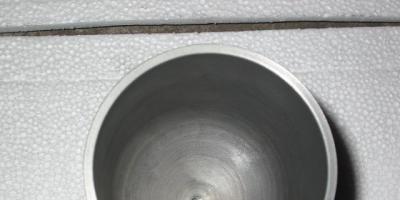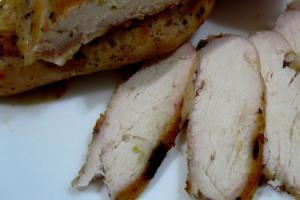Making kitchen facades with your own hands is good way save on buying a kitchen set. Old furniture You can give it a different look by replacing the doors of cabinets and cabinets, installing doors that open upward, and adding fashionable details and beautiful fittings to the set. And even the furniture facades themselves can be made by hand from relatively cheap and affordable materials. 
Similar articles:
Replacing kitchen facades is a great way to update your kitchen set
The furniture facade is the face of the kitchen and the main component of its style. Decorating set homemade parts It should be done only when there is a strong desire to do the work efficiently and accurately, because incorrect assembly can ruin even the best materials.
For self-made solid facades or shaped bent doors will require skills in working with wood, MDF or chipboard, as well as the availability of special tools.
In more simple version Independent updating of a kitchen set with furniture facades is limited to taking measurements and installing updated doors and drawer panels in the intended places. Ready-made parts can be purchased and ordered in furniture stores. There is also a service for sawing and edging selected MDF or laminated chipboard panels. It is difficult to carefully cut laminated boards at home without a special tool.
But even buying or ordering panels in a store will cost less than purchasing ready-made cabinet furniture. Therefore, updating the kitchen by replacing facades is a common design technique.
Manufacturing options from different materials
Most often, do-it-yourself kitchen facades are made from wood. This is an easy-to-process, accessible and cheap raw material for the production of materials for the furniture industry. Kitchen facades must be resistant to exposure detergents, temperature and humidity, and wood and laminated panels meet these conditions.
It is easy to make facades with your own hands from the following materials:
- solid wood;
- plywood;
- pressed (chipboard, chipboard, MDF).
To work with the listed types of furniture raw materials, no sophisticated equipment is required; wood can be cut with a jigsaw or a hand saw.
Plywood facades resemble massive ones: upper layer Birch plywood has a distinct wood structure; some types of material have a moisture-resistant coating that gives smoothness and a slight shine. To make plywood facades, it is better to choose thick varieties (2-3 cm). This will install mortise hinges for furniture, and the doors will be durable. Close the edges of the facades special tape, matched to the tone of the wood front side.
If there is no thick plywood, make beautiful facades possible using paneled door technology. In this case, a board about 2 cm thick is used for the frame, and the inserts are made of plywood.
With the help of additional decor (molding, painting, patination or staining) you can achieve good result, having made updated facades for kitchen furniture with our own hands.
From MDF
The simplest option for making a facade from MDF is to take the dimensions of doors and panels and order products in furniture store. Having chosen panels with a coating of the desired color, the measurement results must be given to the master. On professional equipment The material will be cut and the edges will be glued on. The customer will only have to pick up the facades prepared for installation and hang them with his own hands.
When cutting laminated MDF panels yourself, you will not be able to avoid chipping the coating along the cut line. Therefore, when cutting, you need to make an allowance of 2-3 mm around the entire perimeter of the facade. After sawing, process the edges sandpaper, cleaning the cuts.
To stick the edges with your own hands, it is better to use PVC tape of the desired shade. The material can be easily secured to the edges of the facade using a hot iron, ironing the tape through thick paper. If it is possible to use a router at home, you will be able to perform edging with a tenon tape.
The choice of materials for the kitchen must be approached responsibly: plastic covering does not protect against water, and in conditions high humidity such facades quickly lose their shape. When using this type of panel, it is necessary to perform high-quality edging, so it is better to entrust the work to a professional.
Chipboard facade
When choosing a cheap uncoated chipboard, you also need to buy a film for finishing the facade. You can cut a simple chipboard with a jigsaw, and cover the finished facades with film.
Laminated chipboard has a coating that resembles valuable wood or is painted in different colors. It is better to cut such material in a workshop, providing the master with the dimensions of the panels and the location of the hinges. When cutting facades yourself, proceed as follows:
- draw a contour line on the front side of the chipboard;
- Use a sharp knife to cut through the laminated layer of material along a ruler;
- cut the chipboard using a jigsaw along the cut line.
Edging a façade made of chipboard is carried out in the same way as processing MDF.
Glossy
Glossy facades belong to the MDF group. To cover such models use:
- PVC film glued to vacuum equipment on a panel with or without milling;
- acrylic plastic with PVC or aluminum edge;
- special technology of painting with enamel and varnish.
It is impossible to make such a coating at home. To make fashionable kitchen furniture glossy facade, need to purchase ready material. It is better to order cutting and gluing of the edges in a workshop, because when sanding with your own hands, the shiny layer will be damaged, and the facade will not look as elegant as in advertising photos.
When using glossy facades, careful attention to the products will be required. The slightest dirt or fingerprints are clearly visible on the shiny surface. The surface is easily damaged by minor mechanical impact, and the film coating is unstable and resistant to high temperatures.
Handles are not only a functional piece of furniture. They complement and decorate the facades. In styles with strict lines (minimalism, hi-tech), handles sometimes serve as an emphasizing element: large, shiny, but simple in outline fittings are used. Such handles resemble roof rails and are located both vertically and horizontally.
It is better not to weigh down the lightness of fashionable sets with glossy facades or made in the Art Nouveau style with additional fittings. For such kitchens, methods have been invented to open without the help of handles, when you press the door. But sometimes such cabinets are equipped with special fittings, disguising the handle as an aluminum edge.
For rustic and luxurious styles, it is customary to choose antique handles, with a coating that imitates old bronze or made of non-ferrous metal. These are elaborate cast products that should be combined with the decor of the facade.
The handles must be installed after hanging the facades on the cabinets. To ensure that the entire line of handles is placed at the same height above the floor, you can stretch the cord along the entire front of the lower tier. Along this line you need to make marks for installing the handle on each door. The same applies when installing handles on drawers or wall cabinets.
How to correctly install handles on the facades in each individual case is written in the instructions for these products. Holes for their installation can be made different ways: through in the plane, closed at the ends or in some other way. When purchasing handles, it is better to purchase several pieces for repairs during use, since these products may be discontinued, and it will be difficult to find a replacement if necessary.
What do you do with old furniture?
In the modern world, when progress continues to amaze with its pace of development, many people receive ample opportunities learn on your own what previously seemed impossible. This trend has also affected the furniture sector. Despite the fact that the service of making custom-made furniture is quite well developed today, many people want to learn how to make furniture themselves. Therefore, the question of how to make kitchen facades with your own hands remains relevant for many people.
Kitchen furniture plays very important role. The presence of many cabinets and drawers allows you to hide all the kitchen utensils that are necessary in the cooking process. And an important role in kitchen sets facades play a role, as they are needed to perform certain functions and give kitchen furniture special beauty.

Kitchen furniture facades include doors, panels, front part drawers and everything that is located in front of the kitchen furniture.
Furniture facades can be made of various materials. But the most popular materials are:
- solid wood;
- wood boards. These can be MDF boards, chipboards and other similar ones;
- glass;
- aluminum;
- plastic;
Important: when choosing material to make a facade, pay attention to general style kitchen and interior. Having precisely decided on the material, you can begin manufacturing. kitchen facades.
Solid wood facades
The very first rule that owners of an apartment or house must follow is that kitchen facades cannot be selected from photographs or videos. The main criterion for choosing a facade, the production of which will take place with my own hands, will become the material.


If you decide to make a kitchen facade from solid wood, then it is worth considering that they are made in several ways:
- paneled facades made of solid wood;
- solid facades made of solid wood;
Such products can be made various forms and sizes, make them ventilated or solid.
The main advantages of furniture facades made of solid wood are:
- attractive appearance;
- fashionable;
- long service life;
- environmentally friendly;
- installation is quite simple;
Important: V When choosing a technique for making facades from solid wood, you must remember that such material is easy to work with, easy to process, and can be used to make ventilated facades, curved facades, or any other.
Despite positive traits, a facade made of solid wood also has some disadvantages:
- are able to absorb moisture and foreign odors, as a result of which they lose their original appearance;
- solid wood facades require constant maintenance;
- quite high cost of material;
- solid wood facades do not withstand the action of straight lines sun rays;
Plastic facades

Installation of plastic facades is quite simple and unpretentious even for those who are engaged in such a process for the first time. Making such facades is quite simple. To do this, you first need to make a base from MDF or chipboard, and install decorative plastic on top of this base using a special adhesive composition.
Facades, the manufacture of which involves the use of plastic based on MDF or chipboard, have the following advantages:
- shockproof;
- do not require special care;
- are not afraid of direct sunlight and temperature changes;
- are not afraid of moisture;
- have long term operation;
Disadvantages of plastic facades:
- leave handprints on themselves if you touch them;
- matte plastic, which is used in the manufacture of facades for kitchen furniture, is quite difficult to clean;
- side parts plastic facade can't do it without white on the side, which will definitely make it stand out from the general background of the kitchen;
MDF facades
Installation of an MDF facade involves the production special frame, which is subsequently lined and covered with film.


Important: O When installing kitchen facades from MDF, you must remember that materials such as mirror, glass, chipboard, and so on can be used as a profile.
The main advantages of facades for kitchen furniture made of MDF:
- inexpensive material cost;
- quite light in weight;
- you can make curved facades, ventilated and other non-standard shapes;
Disadvantages of kitchen facades made of MDF:
- quite fastidious in care;
- do not tolerate moisture well;
- do not tolerate the effects well high temperatures. Therefore, when installing facades of this type, you should avoid contact, for example, with a gas stove;
- if you make a facade from MDF, then the seams of the profile connection will definitely be visible;
Glass facades
Installation of facades for kitchen furniture made of glass involves the use of a material of increased strength.

Glass is quite easy to process, so if you decide to make curved facades, then glass will play the role of an assistant in your plan.
Main advantages similar products it could be considered:
- aesthetically beautiful appearance;
- tolerate moisture and sun well;
- can withstand blows quite well;
Important: despite the fact that glass facades are quite durable, we must remember that you should not abuse them by hitting them.
The disadvantages of such a material for making facades as glass are:
- have to wash frequently;
- there is always a risk that the glass may break;
Other types of furniture facades
In addition to the above-mentioned facades for kitchen furniture, the manufacture and installation of which can be done independently, there are also the following types:
- Wet facade. This type has gained popularity thanks to manufacturing technology, which involves the use minimum quantity cold bridges. In addition, if you make wet facade with your own hands, you can help move the dew point outside your room;
- Frame facades, which are mostly made from MDF. The installation and manufacturing process of such products is quite simple, and their appearance is excellent. Standard sizes facades - this is not about this type, since they can be made of any size. Such facades can be made in the form of curved ones, or they can be ventilated facades. When making frame facades, you can show your imagination by arranging different colors, which in this case is welcome;
As you can see, there is a large selection of materials from which facades can be made. Considering all the pros and cons of a particular material, you can choose the most suitable option and proceed directly to the process of making the facade for your kitchen.
The history of glossy facades is relatively young; only a few methods or types of manufacturing such facades are widely practiced - these are film facades, PVC film is applied by hot pressing in a vacuum environment. Painted facades - by gradually applying paint in several layers, and then in the same sequence of varnish coating and further polishing. Acrylic facades - by applying glossy acrylic plastic to MDF. Postforming - application of paper-laminated plastic (HPL) to the base in a press under high pressure and corresponding temperature.
All of the listed types are unsuitable for self-production at home; either high-tech equipment or a specially equipped room is required. I want to talk about more in a simple way how to make a facade with a high degree of gloss and perfect flat surface do it yourself using simple hand tools.
We will use Kamellit acrylic plastic as a glossy coating. The plastic is 4mm thick so it doesn't need to be perfect clean room or an expensive press. Due to the thickness of the plastic, debris may inadvertently get in when applying the glue or uneven application itself adhesive composition will not affect the evenness and smoothness of the surface of the coating, which cannot be said when working with materials with a thickness of 1 mm or less, even a very small speck or a layer of glue applied even by spraying will manifest itself on the front part of the facade in the form of swelling or ripples, the irregularities are especially noticeable on dark colors. When working with our material, you don’t have to be afraid of this, the glue will be contact, I prefer to work with Solupren glue, in our case it can be applied with a roller, brush, or just with a swab made of fabric, polyurethane foam (sponge) and there is no need to clean it workroom to the state of a surgical operating room.
To begin with, I would like to show several of our works in which facades were made using the proposed method.  It should be noted that this material much superior in strength, and also has higher dirt-repellent properties than generally accepted ones, classic materials and coatings used in the manufacture of facades in modern furniture.
It should be noted that this material much superior in strength, and also has higher dirt-repellent properties than generally accepted ones, classic materials and coatings used in the manufacture of facades in modern furniture. There are also similar acrylic plastics with a pearlescent effect, Grandsilk. The properties are more unique, for example, handprints are practically invisible even with careful examination. Materials Kamellit And Grandsilk easy to process, cutting is done using circular saw, milling with conventional cutters. But if you try to bend it, you will have to sweat, the material is heat-resistant and to make a radius (bent) facade you need to heat the plastic to 160-180 degrees, with artificial stone much simpler, it is more thermoplastic, although it should be noted that the processing technology of these materials is almost identical.
There are also similar acrylic plastics with a pearlescent effect, Grandsilk. The properties are more unique, for example, handprints are practically invisible even with careful examination. Materials Kamellit And Grandsilk easy to process, cutting is done using circular saw, milling with conventional cutters. But if you try to bend it, you will have to sweat, the material is heat-resistant and to make a radius (bent) facade you need to heat the plastic to 160-180 degrees, with artificial stone much simpler, it is more thermoplastic, although it should be noted that the processing technology of these materials is almost identical.  There are three ways to make facades and decorative panels, at least I describe which I use myself: this preliminary preparation panels with gluing a single sheet of plastic onto a sheet of MDF or chipboard, however, it is not entirely convenient, the format of the plastic sheet is Kamellit 3050×2030×4, Grandsilk 2020×1320×4 i.e. vary from the sizes of MDF and chipboard sheets, laminated chipboard. Then the prepared panels are cut in right size, is convenient because the ends of the parts are already prepared for gluing the edge material; there is no need for additional operations associated with milling and adjusting the ends. The second method is cutting plastic to the size of the part, gluing it to the part, processing the ends (removing overhangs) and gluing the edges. The third method is gluing the edge, gluing the plastic, milling (rounding the edge of the plastic).
There are three ways to make facades and decorative panels, at least I describe which I use myself: this preliminary preparation panels with gluing a single sheet of plastic onto a sheet of MDF or chipboard, however, it is not entirely convenient, the format of the plastic sheet is Kamellit 3050×2030×4, Grandsilk 2020×1320×4 i.e. vary from the sizes of MDF and chipboard sheets, laminated chipboard. Then the prepared panels are cut in right size, is convenient because the ends of the parts are already prepared for gluing the edge material; there is no need for additional operations associated with milling and adjusting the ends. The second method is cutting plastic to the size of the part, gluing it to the part, processing the ends (removing overhangs) and gluing the edges. The third method is gluing the edge, gluing the plastic, milling (rounding the edge of the plastic).
I have shown the third method, first we apply it to the ends of the future facade. PVC edge 1-2mm, preferably glossy and matching the color of the acrylic plastic being glued. On the back side of the facade, we round off the edge chamfer using a 2-3mm milling cutter.  Shown is the back side of the facade with a processed edge.
Shown is the back side of the facade with a processed edge.  On the front side, we mill the protruding edge (remove the overhang) under the face with the plane of the facade detail.
On the front side, we mill the protruding edge (remove the overhang) under the face with the plane of the facade detail.  Further grinder we adjust it to an ideal, even plane, and at the same time grind the lamination, which promotes better adhesion when gluing the plastic and the facade panel.
Further grinder we adjust it to an ideal, even plane, and at the same time grind the lamination, which promotes better adhesion when gluing the plastic and the facade panel.  We clean it from dust, wash it with alcohol or a non-greasy solvent.
We clean it from dust, wash it with alcohol or a non-greasy solvent.  We move on to the stage of gluing the plastic. Apply contact glue to both surfaces to be glued, let dry and press tightly. The better you press, the better and stronger it will hold, the main and probably the most important requirement when working with contact adhesive. And another important point is that you need to accurately determine the drying time of the applied glue before gluing (joining the surfaces to be glued together). Personally, I have been working with this brand of glue for a long time, I determine readiness by the change in color of the drying layer, you can check by touching the back of your hand, there should be no sticking and the glue should not stick and remain on the hand. The manufacturer recommends a certain drying time, but different temperatures indoors, the presence of air movement, sometimes blowing is used or simply due to the shelf life of the glue (with long-term storage the viscosity of the adhesive composition changes), the drying time of the adhesive layer varies greatly. In a word, the quality of gluing also depends on the correctly chosen pre-drying time of the glue.
We move on to the stage of gluing the plastic. Apply contact glue to both surfaces to be glued, let dry and press tightly. The better you press, the better and stronger it will hold, the main and probably the most important requirement when working with contact adhesive. And another important point is that you need to accurately determine the drying time of the applied glue before gluing (joining the surfaces to be glued together). Personally, I have been working with this brand of glue for a long time, I determine readiness by the change in color of the drying layer, you can check by touching the back of your hand, there should be no sticking and the glue should not stick and remain on the hand. The manufacturer recommends a certain drying time, but different temperatures indoors, the presence of air movement, sometimes blowing is used or simply due to the shelf life of the glue (with long-term storage the viscosity of the adhesive composition changes), the drying time of the adhesive layer varies greatly. In a word, the quality of gluing also depends on the correctly chosen pre-drying time of the glue.  Next we work with the plastic itself, first removing the overhangs using copy cutter.
Next we work with the plastic itself, first removing the overhangs using copy cutter. The cutter has a support bearing, the end of the part serves as a template. Milling occurs precisely along the contour of the facade.
The cutter has a support bearing, the end of the part serves as a template. Milling occurs precisely along the contour of the facade.  Next, we round off the sharp edges of the plastic with an edge cutter; the shape of the cutting knives of the cutter can be different.
Next, we round off the sharp edges of the plastic with an edge cutter; the shape of the cutting knives of the cutter can be different.  AND the final stage polish the rounded areas, use polishing paste. If desired, it can be done without polishing.
AND the final stage polish the rounded areas, use polishing paste. If desired, it can be done without polishing.
As you can see, everything is quite simple, you just need a little patience, the process is quite time-consuming.
P.S. I've been using it for a long time this technology, I see only positive aspects, there is only one minus - the expensive cost of acrylic plastic Kamellit.
What can give you more pride than a piece of furniture made by yourself? IN Lately People are increasingly realizing that creating the things they need is not only about saving money, but also about creativity and pleasure. So, you can learn how to make furniture facades. This element of furniture includes everything that is in its front part: front panels and ends of drawers, doors, etc. As experts note, this is a fairly simple matter, but the result will be the most positive.
To ensure a stylish appearance and prestige of the living space, the material for furniture facade should be chosen before starting work, having carefully studied all its advantages and disadvantages.
Features of the material
No one will argue that without facades, furniture loses not only its functionality, but also its aesthetics. Therefore, at all times, the production of these elements was assigned Special attention. People came up with new materials and over time began to use them to make furniture.
Today, furniture facades can be made from:

Furniture facades are made of: plastic, MDF, aluminum, glass.
- wood;
- plastic;
- aluminum;
- glass
Each of these materials has its own advantages and disadvantages. For example, wood fades easily when exposed to sunlight, but is different for a long time operation. Glass, on the contrary, is not afraid of the sun, but can break if accidentally hit. In addition, elements made from some materials require special processing, and they cannot be made at home.
It was not difficult to make beautiful doors for kitchen furniture with a complex combined connection at home. Our author was convinced of this from his own experience.
Seventeen years ago I independently collected kitchen furniture from furniture panels 18 mm thick. The door trim was assembled with a counter-profile connection, and the outer edges were processed with a simple rounding.
The frame of the furniture has remained in good condition since then. But the doors have partially fallen into disrepair, and I decided to update them. I wanted to make them paneled, but instead of panels, insert plywood or glass into the frames. It was necessary to make 12 frames for the doors and 18 for the front panels of the drawers. I contacted a specialized company that manufactures kitchen furniture, but it issued a fabulous bill - 250 thousand rubles. So I had to refuse.
There was only one way out - to make the facades yourself.
Operating procedure
I cut blanks for all door frames and drawer front panels to a width of 60 mm from furniture board. I planned to make five doors glazed, in seven others I would use sanded plywood with a thickness of k mm as an insert, and in the front panels - plywood with a thickness of 6 mm.
I decided to fasten the harness using a combined connection. It consists of two elements - a mustache at an angle of D5 degrees on the front side of the frames and a tongue and groove - at an angle of 90 degrees. The connection is created by a mustache beautiful view(the door looks very decent), and also allows you to process inner edge tying with a cutter of complex configuration.
To avoid confusion, I made grooves in all long blanks, and tenons in short ones. I was able to think through a clear sequence of manufacturing stages without unnecessary actions, which speeded up the process. For personal safety, I did not work with parts thinner than 18 mm and shorter than 200 mm.
I used it when working circular saw Metabo TS 254. The parallel stop on it moves easily, is firmly fixed on both sides of the table, so that it never moves during operation. The height of the saw blade can be adjusted from zero to 75 mm. These advantages of the machine make it easier to make tenons. However, it also has a drawback - the poor location of the switch. I constantly had to look for him.
He performed all the work in a workshop located on the loggia of his apartment. At its end I made a small table, under which the machine is removed in between jobs.
It took me about 40 minutes to make one frame.

1 . I start choosing a groove for inserts (glass and plywood). I pre-prepared the long and short parts of the frames. Saw blade I set it to 6 mm. The distance from the stop to the saw is 50 mm.
2 . Preparation for making a tenon 50 mm long. Only short blanks participate. I keep the height of the disc at 6 mm. The distance from the stop to the saw is h7.5 mm, that is, 50 mm minus 2.5 mm (disk width). Using a miter gauge, I cut short pieces crosswise.
3 . Completion of making the groove for the inserts. Long and short blanks are involved. The distance from the stop to the saw is 12 mm. I gradually raise the saw until the groove is cut completely. The width of the groove was 10 mm, the depth was 6 mm.
4 . I leave the distance from the rip fence to the saw 12 mm. Having attached the part to the disk, I lift it to the bottom edge of the sample.
5 . Making a tenon on short parts. Disc height - 50 mm. From the stop to the saw - 12 mm. I carefully and slowly move the short workpiece along the stop, pressing it against it. (The selection should always be on the left side.)
6 . Short blanks with prepared spikes without a mustache.
7 . Only the long parts of the harnesses are involved. I apply the workpiece to the disk and lift it to the outer edge - 60 mm. I reduce the distance from the stop to the saw by 2.5 mm (by the thickness of the disk).
8 . Preparing tenons on long workpieces. I carefully and calmly move the long pieces along the rip fence several times. I reduce the distance from the stop to the saw by 2.5 mm, then by 1 mm. The width of the spike is 6 mm. (The space for inserts must be on the left side.)
9 . Formation of a mustache over long sections. I turn the angle stop 45 degrees. The distance from the rip fence to the disk is 40 mm. I lower the disk to 5 mm. Moving the long workpiece along the parallel stop, I gradually raise the disk so as to cut out a triangle.
10 . I finally form a groove with two sides - one on the miter side, the other at an angle of 90 degrees.

11 . Formation of a mustache on the tenon of short blanks. The distance from the rip fence to the disk is 40 mm. Disc height - 5 mm. I select the angle of the workpiece, gradually raising the disk until the tip of the tenon fits into the groove of the long piece with a slight effort. Thanks to many back-and-forth movements, I complete the selection of the whisker on the spike.
12 . I assemble the harnesses without glue and check the connections. (In the photo - frames for the front panels of the drawers.)
Processing the inner edge of the straps
Before assembling the bindings using PVA glue, I processed the inner edges of the bindings with an edge cutter of a complex configuration. But there was a small problem here. The edge cutter has a small bearing (guide pin), which, when processing the workpiece, can get into the insertion hole, which will lead to disruption of the milling pattern - and the work will be ruined.
To eliminate accidental cutting of the cutter into the wood, I made a special device - a bed. I made it from a shield 1 m long and 60 mm wide. The profile of the crib mirrors the profile of the harness blank on the back side. Where the harness has a groove for the insert, there is a protrusion of the same size on the crib. A block was glued to the edge of the crib opposite the ledge. The workpiece from the frame lies with the sample down on the ledge and rests against the block. Now the cutter bearing rolls along the outside of the protrusion, and the glued block prevents the workpiece from moving while the router is running.
13 . Bed for milling trim blanks. On the right is a protrusion, on the left is a glued block that serves as a stop.
14 . Processing the inner edge of workpieces with an edge cutter. The workpiece lies as a sample for inserts on the protrusion of the crib and rests against the block glued to the left. An edge cutter with a bearing moves along the outside of the crib projection and processes the inner edge of the workpiece.
15 . Trim parts prepared for assembly. Above are details from the front side. Below are parts from the back side (a tenon, a groove at a right angle and a recess for inserts are visible).








